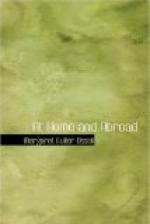On this our second visit, after an absence of near a fortnight in the Highlands, we are at a hotel nearly facing the new monument to Scott, and the tallest buildings of the Old Town. From my windows I see the famous Kirk, the spot where the old Tolbooth was, and can almost distinguish that where Porteous was done to death, and other objects described in the most dramatic part of “The Heart of Mid-Lothian.” In one of these tall houses Hume wrote part of his History of England, and on this spot still nearer was the home of Allan Ramsay. A thousand other interesting and pregnant associations present themselves every time I look out of the window.
In the open square between us and the Old Town is to be the terminus of the railroad, but as the building will be masked with trees, it is thought it will not mar the beauty of the place; yet Scott could hardly have looked without regret upon an object that marks so distinctly the conquest of the New over the Old, and, appropriately enough, his statue has its back turned that way. The effect of the monument to Scott is pleasing, though without strict unity of thought or original beauty of design. The statue is too much hid within the monument, and wants that majesty of repose in the attitude and drapery which a sitting figure should have, and which might well accompany the massive head of Scott. Still the monument is an ornament and an honor to the city. This is now the fourth that has been erected within two years to commemorate the triumphs of genius. Monuments that have risen from the same idea, and in such quick succession, to Schiller, to Goethe, to Beethoven, and to Scott, signalize the character of the new era still more happily than does the railroad coming up almost to the foot of Edinburgh Castle.
The statue of Burns has been removed from the monument erected in his honor, to one of the public libraries, as being there more accessible to the public. It is, however, entirely unworthy its subject, giving the idea of a smaller and younger person, while we think of Burns as of a man in the prime of manhood, one who not only promised, but was, and with a sunny glow and breadth, of character of which this stone effigy presents no sign.
A Scottish gentleman told me the following story, which would afford the finest subject for a painter capable of representing the glowing eye and natural kingliness of Burns, in contrast to the poor, mean puppets he reproved.
Burns, still only in the dawn of his celebrity, was invited to dine with one of the neighboring so-called gentry (unhappily quite void of true gentle blood). On arriving he found his plate set in the servants’ room!! After dinner he was invited into a room where guests were assembled, and, a chair being placed for him at the lower end of the board, a glass of wine was offered, and he was requested to sing one of his songs for the entertainment of the company. He drank off the wine, and thundered forth in reply his grand song, “For a’ that and a’ that,” with which it will do no harm to refresh the memories of our readers, for we doubt there may be, even in Republican America, those who need the reproof as much, and with far less excuse, than had that Scottish company.




